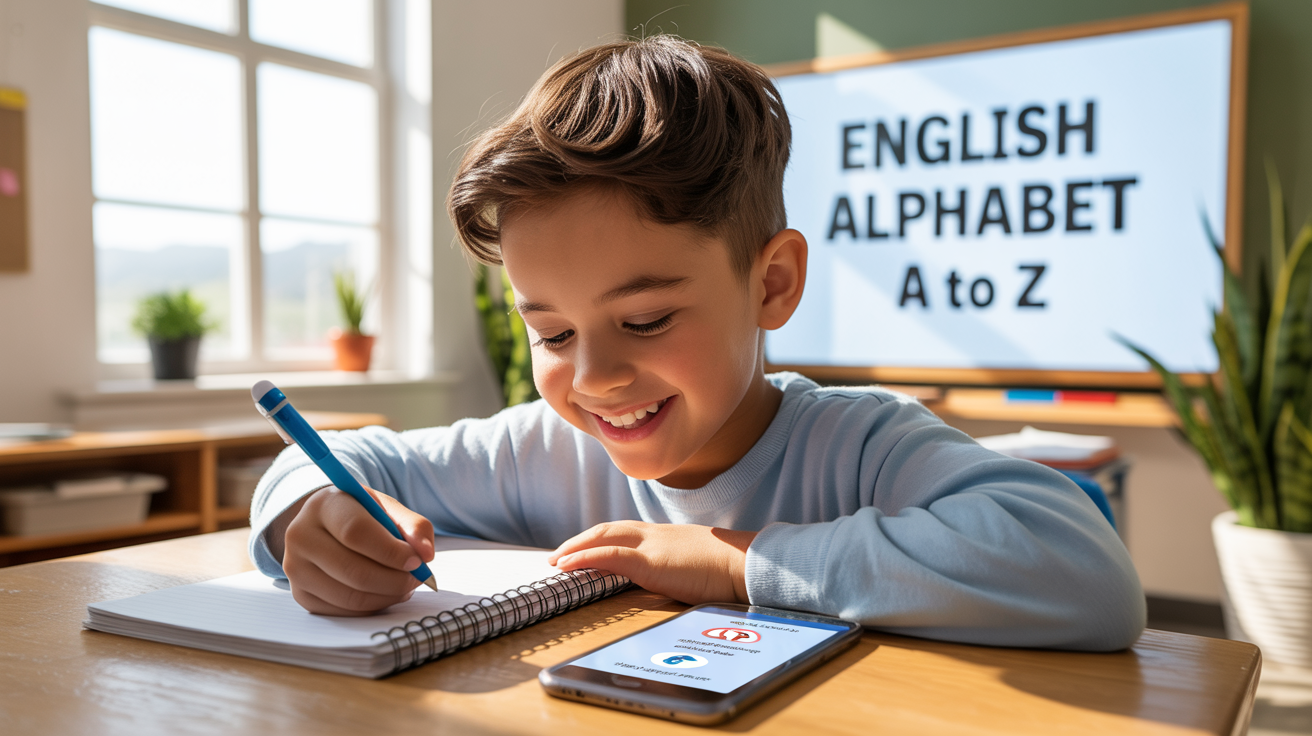Learning a new language can be challenging, especially when you’re doing it on your own. The good news? With the right tools and mindset, you can improve your English at home, even without a teacher or conversation partner.
Whether you’re preparing for a test, planning to travel, or want to feel more confident using English daily, this guide offers practical ways to practice listening, speaking, reading, and writing — all by yourself.
Let’s get started!
Create a Study Routine That Works
Consistency is key when learning any language. Without regular practice, progress slows down quickly. The first step is to build a routine that fits your daily life.
Here’s how:
- Set a specific time each day to study — even if it’s just 20–30 minutes.
- Use a calendar or habit tracker app to mark your study days and stay motivated.
- Break your study sessions into smaller chunks focused on different skills:
- 10 minutes of listening
- 15 minutes of reading
- 10 minutes of writing
This keeps things interesting and makes it easier to stay consistent.
Improve Your Listening Skills at Home
Listening is crucial for understanding spoken English and improving your ability to speak naturally. The more you listen, the better you’ll get.
Free Resources for Listening Practice
Here are some great places to start:
- YouTube Channels:
- BBC Learning English – Short, easy-to-follow lessons.
- Speak English with Mr Duncan – Great for everyday conversations.
- English Addict with Mr Steve – Fun and engaging for beginners.
- Podcasts:
- ESL Pod – Slow, clear speech with explanations.
- Luke’s English Podcast – More advanced but full of useful expressions.
- The English We Speak (BBC) – Teaches common phrases in 3-minute episodes.
- Movies and TV Shows:
- Watch shows like Friends, Modern Family, or How I Met Your Mother. Start with subtitles in your native language, then switch to English subtitles, and eventually try watching without subtitles.
Active Listening Exercises You Can Do Alone
- Listen to a short clip and write down what you hear.
- Pause after each sentence and repeat what was said.
- Answer simple questions about what happened in the video or audio.
These small steps train your ears and improve comprehension over time.
Speaking Practice Without a Partner
Speaking might seem tricky to practice alone, but there are many techniques to improve fluency and pronunciation.
Self-Talk Techniques
Talk to yourself out loud about your day, describe what you see, or explain how to do something. This builds confidence and keeps your brain thinking in English.
Shadowing Method Explained
Shadowing involves repeating what a speaker says at the same time as they say it. It helps with rhythm, intonation, and pronunciation.
To shadow:
- Choose a short audio or video clip.
- Listen carefully and follow along with the transcript.
- Repeat each sentence immediately after the speaker says it.
Do this for 5–10 minutes daily, and you’ll notice improvements quickly.
Record Yourself and Review
Use your phone or computer to record yourself reading aloud or talking about a topic. Play it back and listen for clarity, mistakes, and pronunciation issues. Over time, you’ll sound more natural.
AI Tools for Speaking Practice
Try apps like ELSA Speak or Replika — they offer voice recognition and interactive conversations for real-world speaking practice.
Reading Skills Development
Reading expands vocabulary, improves grammar, and teaches natural sentence structures. Plus, there’s tons of free content online.
Choose the Right Reading Material
Start with texts that match your level:
- Graded readers (like Oxford Bookworms)
- News articles from BBC Learning English or Simple English Wikipedia
- Short stories or blogs written for language learners
As you improve, move to more complex material.
Recommended Websites and Apps
- News in Levels – News articles at three difficulty levels.
- Breaking News English – Lessons based on real news events.
- Medium.com – Search for blogs tagged “Learn English” or “Language Learning”.
Vocabulary Building Through Reading
Highlight or note down new words while reading. Look them up and write example sentences to help you remember them.
Skimming and Scanning Techniques
Skimming means reading quickly to find the main idea. Scanning means looking for specific information, like a name or date. Both improve comprehension speed.
Keep a Reading Journal
Write a short summary of what you read each day. This reinforces understanding and builds writing skills.
Writing Practice at Home
Writing helps you organize thoughts and reinforce grammar and vocabulary.
Daily Writing Prompts
Start with simple topics:
- What did you do today?
- Describe your favorite food.
- Write about your dream vacation.
Find free writing prompts online or create your own.
Keep an English Diary or Journal
Write a few sentences daily about your experiences, feelings, or goals. Over time, your style and vocabulary will improve.
Write Emails, Social Media Posts, or Short Stories
Practice writing messages, social media comments, or mini-stories. Make it fun and realistic.
Get Feedback Using Grammar Checkers
Tools like Grammarly or Hemingway Editor catch spelling and grammar mistakes and explain errors to help you learn.
Practice Common Structures and Tenses
Focus on one grammar point at a time, like practicing past tense verbs by describing your weekend.
Vocabulary Building Techniques
A strong vocabulary makes speaking, listening, reading, and writing easier.
Flashcards (Digital and Physical)
Apps like Anki or Quizlet let you create digital flashcards for regular review. Paper flashcards work well too — review them during breaks.
Learn Vocabulary in Context
Learn words through reading, listening, or watching videos instead of memorizing random lists. Seeing words in use helps retention.
Word Lists for Common Topics
Create word lists for topics you care about:
- Travel
- Food
- Work
- Hobbies
- Technology
Review these lists often and use the words in sentences.
Use New Words in Sentences
After learning a new word, write and say a sentence using it to internalize it.
Apps That Help with Vocabulary Retention
- Duolingo
- Memrise
- HelloTalk (language exchange + vocabulary practice)
Grammar Practice Without a Teacher
Grammar is the foundation of any language. Here’s how to study it independently.
Online Grammar Resources
- British Council LearnEnglish
- Cambridge English Grammar
- Perfect English Grammar (YouTube)
All offer free lessons and exercises for self-learners.
Recommended Grammar Books
- English Grammar in Use by Raymond Murphy (with answers for self-checking)
- Azar Grammar Series
Do Grammar Exercises Online
Websites like GrammarBank or EnglishPage offer hundreds of free quizzes and tests.
Create a Grammar Rules Cheat Sheet
Write down rules you struggle with, like present vs. past tense or subject-verb agreement, and keep it visible.
Review Mistakes and Track Progress
Keep a notebook of common errors. Write them down, correct them, and review weekly.
Use Technology and Apps to Improve English
Technology makes self-learning easier than ever. Here are some top tools:
Best Apps for Self-Study
- Duolingo – Fun, gamified lessons for beginners.
- Beelinguapp – Compare audiobooks in two languages side-by-side.
- HelloTalk – Chat with native speakers while correcting each other’s language.
- Memrise – Uses real-life videos to teach vocabulary and phrases.
Online Dictionaries and Translators
Use Cambridge Dictionary or Oxford Learner’s Dictionaries for clear definitions and examples. Google Translate is okay for basic translations but always double-check with a learner-friendly dictionary.
Language Exchange Platforms
Sites like Tandem or Speaky connect you with people who want to learn your language while helping you with English.
Microlearning with Mobile Apps
Even 5–10 minutes daily on a language app helps. Use waiting times, commutes, or breaks to review vocabulary or complete exercises.
Turn Your Phone into an English Tool
Change your phone’s language settings to English. Switch browsers and social media apps to English mode. Read notifications, app descriptions, and menus in English.
Create an English Environment at Home
Surrounding yourself with English helps you absorb the language naturally.
Change Device Language Settings
Switch your phone, laptop, and tablet to English to recognize words and phrases automatically.
Label Household Items
Put sticky notes on objects around your house with their English names, like “lamp,” “refrigerator,” or “window.”
Watch English Media Instead of Native Language
Replace your usual entertainment with English content. Watch YouTube videos, documentaries, or cartoons in English.
Think in English Instead of Translating
Challenge yourself to form ideas directly in English instead of translating from your native language.
Surround Yourself with English Visuals
Hang posters with English quotes, idioms, or vocabulary lists. Set your desktop background to an English phrase or image.
Stay Motivated While Learning Alone
Motivation can fade when studying solo. Here’s how to stay strong:
Set Small Milestones
Break big goals into smaller ones:
- Finish one chapter of a book this week.
- Understand a full podcast episode.
- Write 5 sentences in English daily.
Celebrate each achievement, no matter how small.
Track Your Progress
Use a journal or app to track what you study and how you feel about your progress. Seeing improvement boosts motivation.
Find Inspiration from Others
Follow learners online or join groups where people share their language journeys.
Join Online Communities
Forums like Reddit’s r/languagelearning or Facebook groups offer tips, encouragement, and support.
Overcome Plateaus and Frustration
When progress feels slow, change your routine, revisit old materials, or try a new method. Don’t give up — it’s part of the process!
Measure Your Progress
Regular assessments help you see improvements and identify areas to work on.
Assess Improvement Regularly
Record your speaking, compare old and new writing samples, or take online quizzes.
Take Free Online Placement Tests
Sites like Cambridge English or EF SET offer free tests to check your level.
Compare Old vs. New Samples
Listen to old recordings or re-read journals from a month ago. You’ll likely notice clearer pronunciation and better structure.
Set New Goals Based on Results
Adjust your study plan to focus on weaknesses after assessing your strengths.
Common Mistakes to Avoid When Practicing Alone
Even the best learners make mistakes. Watch out for these:
- Not practicing all four skills equally (listening, speaking, reading, writing).
- Relying too much on translation instead of thinking in English.
- Skipping review sessions — repetition is essential!
- Trying to learn too much at once and getting overwhelmed.
- Giving up after a bad day — consistency beats perfection.
Final Thoughts
Practicing English alone at home might seem hard at first, but with the right strategies and tools, it’s absolutely possible — and even enjoyable!
Remember:
- Build a daily routine.
- Use free resources wisely.
- Practice all language skills.
- Surround yourself with English.
- Stay consistent and celebrate progress.
Learning a language takes time, but every small step leads to big results.
Frequently Asked Questions (FAQ)
Can I really improve my English alone?
Yes! Many people successfully learn English using books, apps, podcasts, and videos.
How long does it take to improve?
It depends on how much you practice. With daily effort, noticeable progress can happen within a few months.
Do I need a tutor?
Not necessarily. A tutor helps with speaking and feedback, but self-study can lead to a high level.
What are the best free resources for learning English?
Top choices include BBC Learning English, Duolingo, YouTube channels, and apps like Beelinguapp.
How do I know if I’m making progress?
Track your speaking, writing, and listening skills over time. If you understand more and express yourself better, you’re moving forward!
Share Your Tips
What’s your favorite way to practice English at home? Share your tips in the comments below!
Don’t forget to share this post with friends who are also learning English — together, we learn faster!




